ACC 707 Auditing: Risk Assessment, Procedures, and ASA 701
VerifiedAdded on 2023/04/23
|12
|3330
|196
Report
AI Summary
This report provides an analysis of auditing and assurance services, focusing on risk assessment and audit procedures for Advanced Computer Solutions Limited's inventory and Green Machine Limited's property, plant, and equipment (PPE). It identifies key assertions at risk, such as valuation and completeness for inventory, and inaccurate accounting of expenditure and improper accounting estimates for PPE. Substantive audit procedures are outlined for each assertion, including physical verification, sales return verification, and purchase/sale bill verification. The report also discusses the requirements of ASA 701 regarding communicating key audit matters in the auditor's report, including necessary disclosures related to inventory valuation and supply agreements below cost price. The analysis considers factors like increased sales returns, inventory turnover rates, and accounting estimates, emphasizing the importance of proper valuation, recording, and measurement in financial statements. The report concludes with recommendations for auditors to address identified risks and ensure compliance with auditing standards.
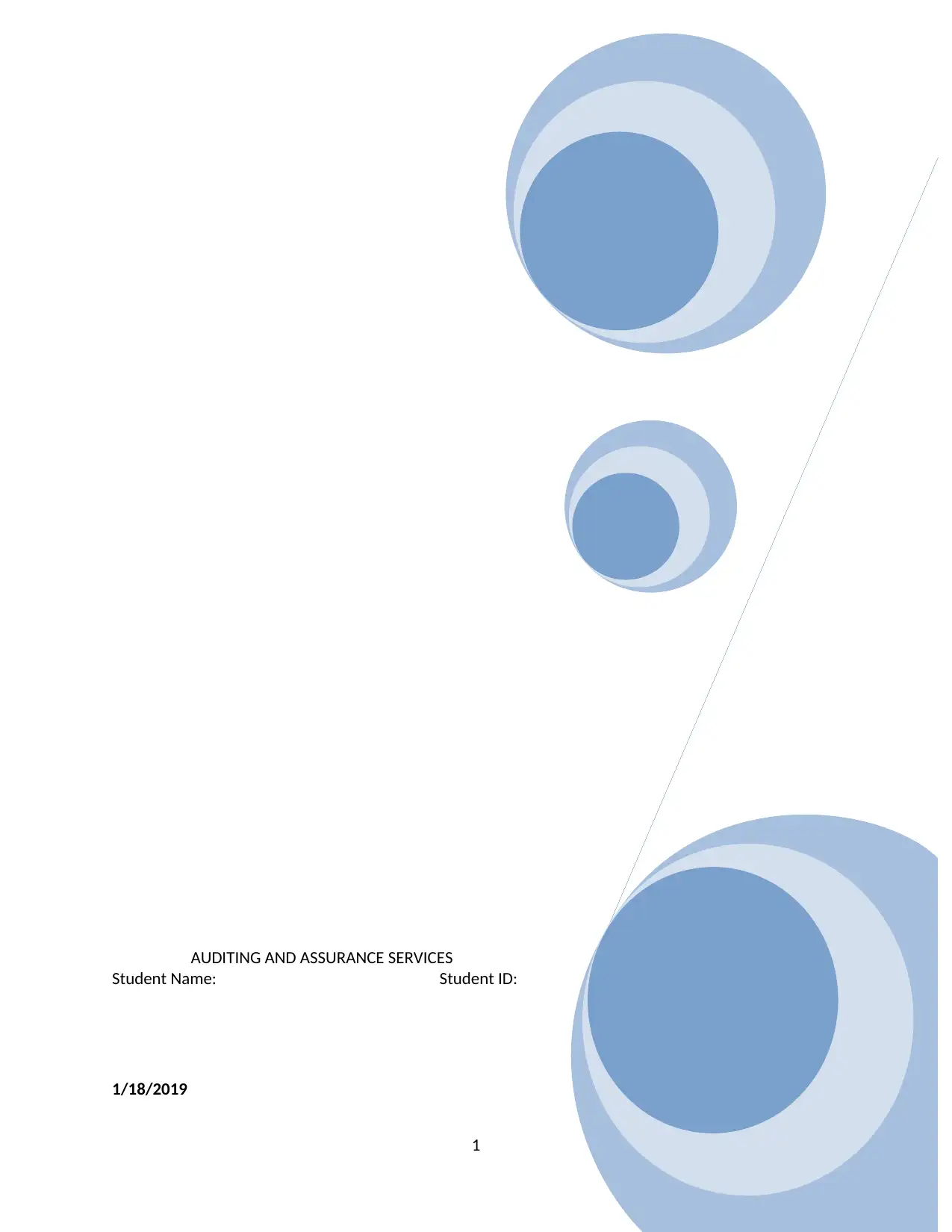
1
AUDITING AND ASSURANCE SERVICES
Student Name: Student ID:
1/18/2019
AUDITING AND ASSURANCE SERVICES
Student Name: Student ID:
1/18/2019
Paraphrase This Document
Need a fresh take? Get an instant paraphrase of this document with our AI Paraphraser
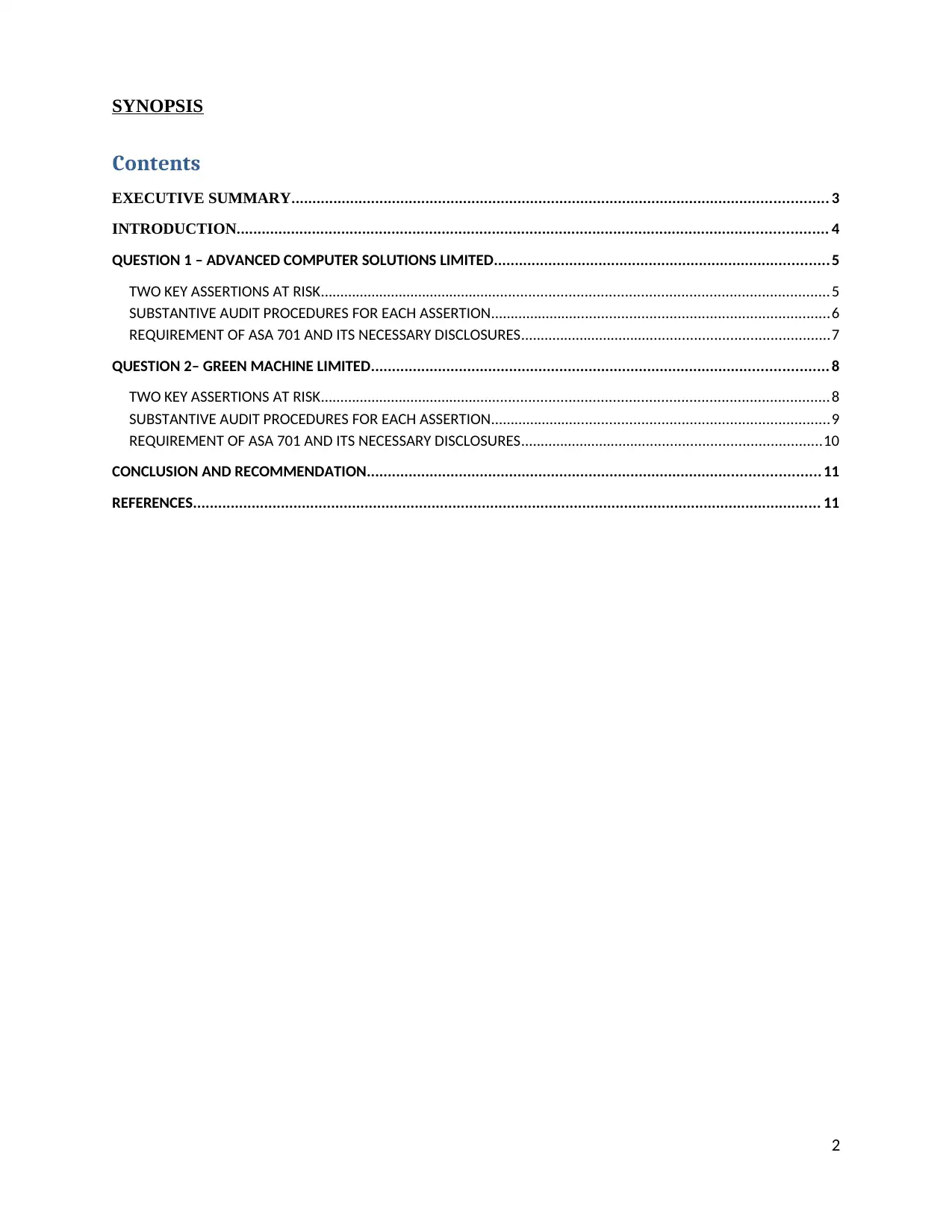
SYNOPSIS
Contents
EXECUTIVE SUMMARY................................................................................................................................ 3
INTRODUCTION............................................................................................................................................. 4
QUESTION 1 – ADVANCED COMPUTER SOLUTIONS LIMITED................................................................................5
TWO KEY ASSERTIONS AT RISK................................................................................................................................5
SUBSTANTIVE AUDIT PROCEDURES FOR EACH ASSERTION.....................................................................................6
REQUIREMENT OF ASA 701 AND ITS NECESSARY DISCLOSURES..............................................................................7
QUESTION 2– GREEN MACHINE LIMITED............................................................................................................. 8
TWO KEY ASSERTIONS AT RISK................................................................................................................................8
SUBSTANTIVE AUDIT PROCEDURES FOR EACH ASSERTION.....................................................................................9
REQUIREMENT OF ASA 701 AND ITS NECESSARY DISCLOSURES............................................................................10
CONCLUSION AND RECOMMENDATION............................................................................................................ 11
REFERENCES...................................................................................................................................................... 11
2
Contents
EXECUTIVE SUMMARY................................................................................................................................ 3
INTRODUCTION............................................................................................................................................. 4
QUESTION 1 – ADVANCED COMPUTER SOLUTIONS LIMITED................................................................................5
TWO KEY ASSERTIONS AT RISK................................................................................................................................5
SUBSTANTIVE AUDIT PROCEDURES FOR EACH ASSERTION.....................................................................................6
REQUIREMENT OF ASA 701 AND ITS NECESSARY DISCLOSURES..............................................................................7
QUESTION 2– GREEN MACHINE LIMITED............................................................................................................. 8
TWO KEY ASSERTIONS AT RISK................................................................................................................................8
SUBSTANTIVE AUDIT PROCEDURES FOR EACH ASSERTION.....................................................................................9
REQUIREMENT OF ASA 701 AND ITS NECESSARY DISCLOSURES............................................................................10
CONCLUSION AND RECOMMENDATION............................................................................................................ 11
REFERENCES...................................................................................................................................................... 11
2
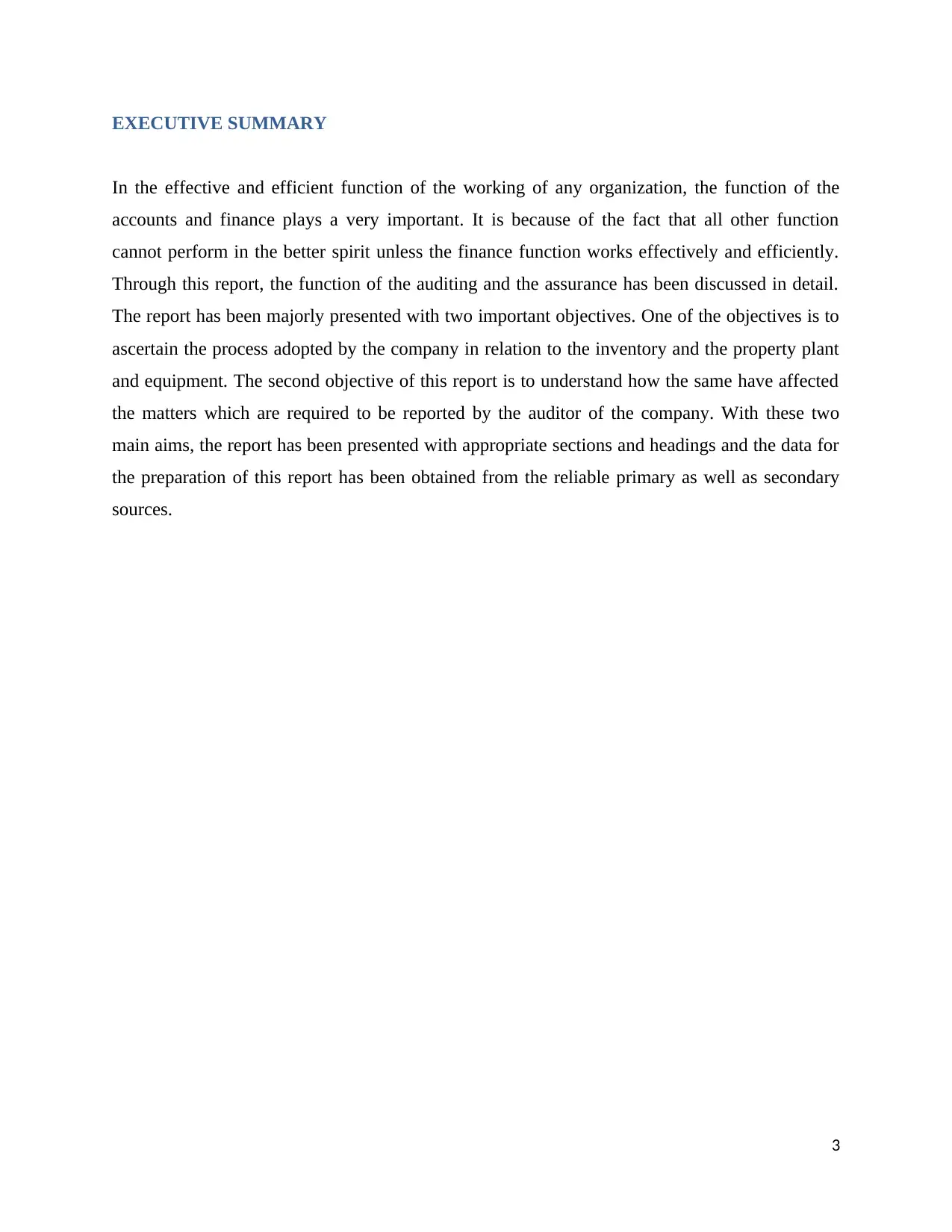
EXECUTIVE SUMMARY
In the effective and efficient function of the working of any organization, the function of the
accounts and finance plays a very important. It is because of the fact that all other function
cannot perform in the better spirit unless the finance function works effectively and efficiently.
Through this report, the function of the auditing and the assurance has been discussed in detail.
The report has been majorly presented with two important objectives. One of the objectives is to
ascertain the process adopted by the company in relation to the inventory and the property plant
and equipment. The second objective of this report is to understand how the same have affected
the matters which are required to be reported by the auditor of the company. With these two
main aims, the report has been presented with appropriate sections and headings and the data for
the preparation of this report has been obtained from the reliable primary as well as secondary
sources.
3
In the effective and efficient function of the working of any organization, the function of the
accounts and finance plays a very important. It is because of the fact that all other function
cannot perform in the better spirit unless the finance function works effectively and efficiently.
Through this report, the function of the auditing and the assurance has been discussed in detail.
The report has been majorly presented with two important objectives. One of the objectives is to
ascertain the process adopted by the company in relation to the inventory and the property plant
and equipment. The second objective of this report is to understand how the same have affected
the matters which are required to be reported by the auditor of the company. With these two
main aims, the report has been presented with appropriate sections and headings and the data for
the preparation of this report has been obtained from the reliable primary as well as secondary
sources.
3
⊘ This is a preview!⊘
Do you want full access?
Subscribe today to unlock all pages.

Trusted by 1+ million students worldwide
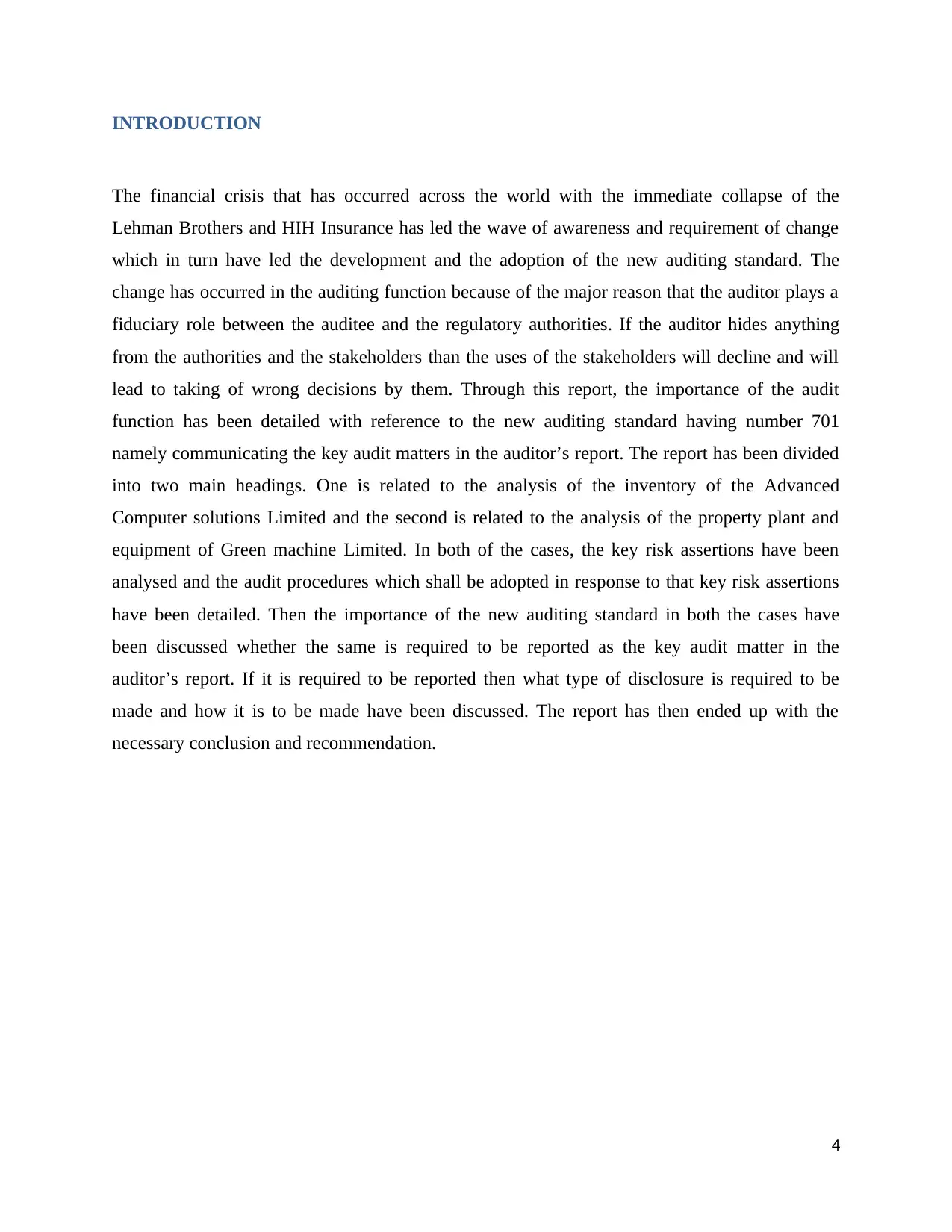
INTRODUCTION
The financial crisis that has occurred across the world with the immediate collapse of the
Lehman Brothers and HIH Insurance has led the wave of awareness and requirement of change
which in turn have led the development and the adoption of the new auditing standard. The
change has occurred in the auditing function because of the major reason that the auditor plays a
fiduciary role between the auditee and the regulatory authorities. If the auditor hides anything
from the authorities and the stakeholders than the uses of the stakeholders will decline and will
lead to taking of wrong decisions by them. Through this report, the importance of the audit
function has been detailed with reference to the new auditing standard having number 701
namely communicating the key audit matters in the auditor’s report. The report has been divided
into two main headings. One is related to the analysis of the inventory of the Advanced
Computer solutions Limited and the second is related to the analysis of the property plant and
equipment of Green machine Limited. In both of the cases, the key risk assertions have been
analysed and the audit procedures which shall be adopted in response to that key risk assertions
have been detailed. Then the importance of the new auditing standard in both the cases have
been discussed whether the same is required to be reported as the key audit matter in the
auditor’s report. If it is required to be reported then what type of disclosure is required to be
made and how it is to be made have been discussed. The report has then ended up with the
necessary conclusion and recommendation.
4
The financial crisis that has occurred across the world with the immediate collapse of the
Lehman Brothers and HIH Insurance has led the wave of awareness and requirement of change
which in turn have led the development and the adoption of the new auditing standard. The
change has occurred in the auditing function because of the major reason that the auditor plays a
fiduciary role between the auditee and the regulatory authorities. If the auditor hides anything
from the authorities and the stakeholders than the uses of the stakeholders will decline and will
lead to taking of wrong decisions by them. Through this report, the importance of the audit
function has been detailed with reference to the new auditing standard having number 701
namely communicating the key audit matters in the auditor’s report. The report has been divided
into two main headings. One is related to the analysis of the inventory of the Advanced
Computer solutions Limited and the second is related to the analysis of the property plant and
equipment of Green machine Limited. In both of the cases, the key risk assertions have been
analysed and the audit procedures which shall be adopted in response to that key risk assertions
have been detailed. Then the importance of the new auditing standard in both the cases have
been discussed whether the same is required to be reported as the key audit matter in the
auditor’s report. If it is required to be reported then what type of disclosure is required to be
made and how it is to be made have been discussed. The report has then ended up with the
necessary conclusion and recommendation.
4
Paraphrase This Document
Need a fresh take? Get an instant paraphrase of this document with our AI Paraphraser
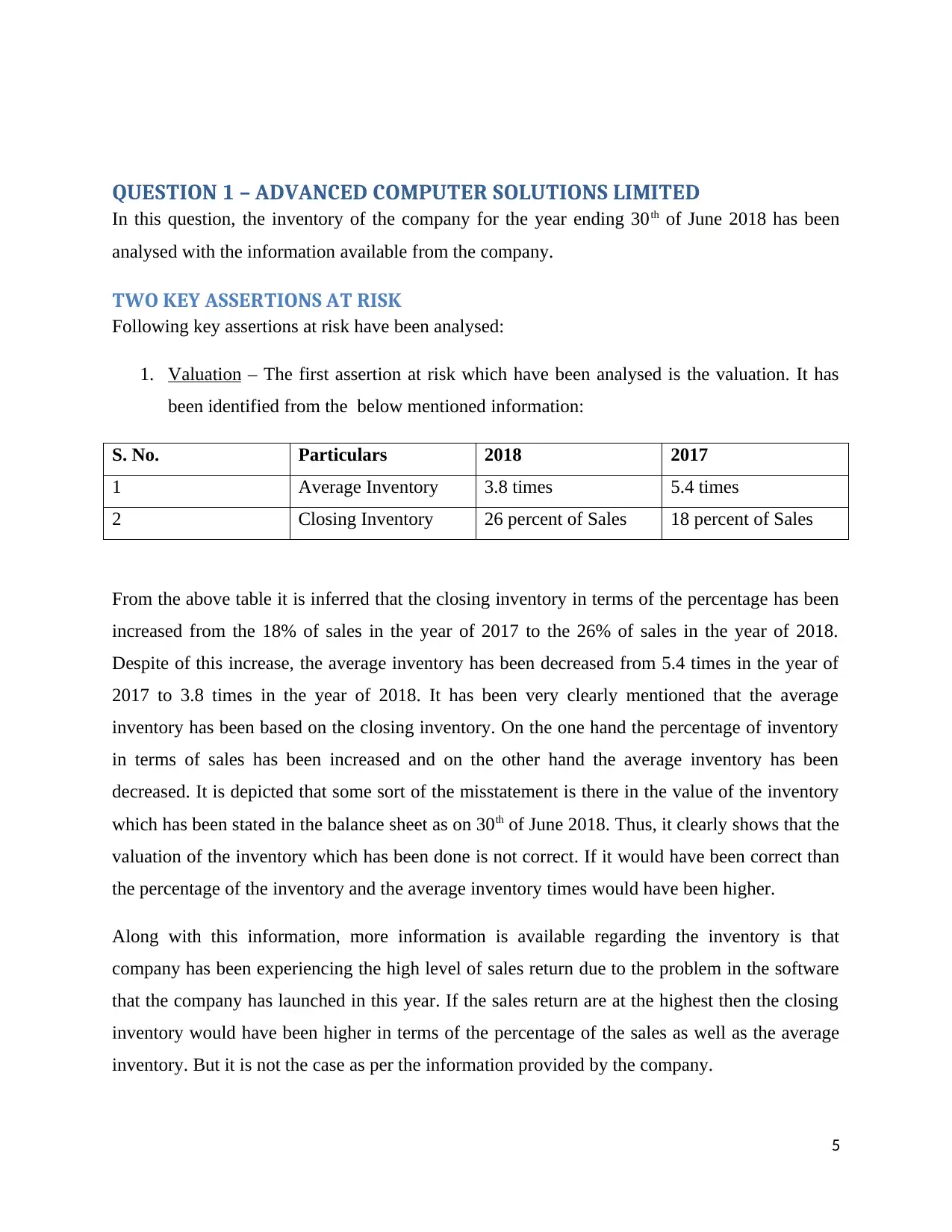
QUESTION 1 – ADVANCED COMPUTER SOLUTIONS LIMITED
In this question, the inventory of the company for the year ending 30th of June 2018 has been
analysed with the information available from the company.
TWO KEY ASSERTIONS AT RISK
Following key assertions at risk have been analysed:
1. Valuation – The first assertion at risk which have been analysed is the valuation. It has
been identified from the below mentioned information:
S. No. Particulars 2018 2017
1 Average Inventory 3.8 times 5.4 times
2 Closing Inventory 26 percent of Sales 18 percent of Sales
From the above table it is inferred that the closing inventory in terms of the percentage has been
increased from the 18% of sales in the year of 2017 to the 26% of sales in the year of 2018.
Despite of this increase, the average inventory has been decreased from 5.4 times in the year of
2017 to 3.8 times in the year of 2018. It has been very clearly mentioned that the average
inventory has been based on the closing inventory. On the one hand the percentage of inventory
in terms of sales has been increased and on the other hand the average inventory has been
decreased. It is depicted that some sort of the misstatement is there in the value of the inventory
which has been stated in the balance sheet as on 30th of June 2018. Thus, it clearly shows that the
valuation of the inventory which has been done is not correct. If it would have been correct than
the percentage of the inventory and the average inventory times would have been higher.
Along with this information, more information is available regarding the inventory is that
company has been experiencing the high level of sales return due to the problem in the software
that the company has launched in this year. If the sales return are at the highest then the closing
inventory would have been higher in terms of the percentage of the sales as well as the average
inventory. But it is not the case as per the information provided by the company.
5
In this question, the inventory of the company for the year ending 30th of June 2018 has been
analysed with the information available from the company.
TWO KEY ASSERTIONS AT RISK
Following key assertions at risk have been analysed:
1. Valuation – The first assertion at risk which have been analysed is the valuation. It has
been identified from the below mentioned information:
S. No. Particulars 2018 2017
1 Average Inventory 3.8 times 5.4 times
2 Closing Inventory 26 percent of Sales 18 percent of Sales
From the above table it is inferred that the closing inventory in terms of the percentage has been
increased from the 18% of sales in the year of 2017 to the 26% of sales in the year of 2018.
Despite of this increase, the average inventory has been decreased from 5.4 times in the year of
2017 to 3.8 times in the year of 2018. It has been very clearly mentioned that the average
inventory has been based on the closing inventory. On the one hand the percentage of inventory
in terms of sales has been increased and on the other hand the average inventory has been
decreased. It is depicted that some sort of the misstatement is there in the value of the inventory
which has been stated in the balance sheet as on 30th of June 2018. Thus, it clearly shows that the
valuation of the inventory which has been done is not correct. If it would have been correct than
the percentage of the inventory and the average inventory times would have been higher.
Along with this information, more information is available regarding the inventory is that
company has been experiencing the high level of sales return due to the problem in the software
that the company has launched in this year. If the sales return are at the highest then the closing
inventory would have been higher in terms of the percentage of the sales as well as the average
inventory. But it is not the case as per the information provided by the company.
5
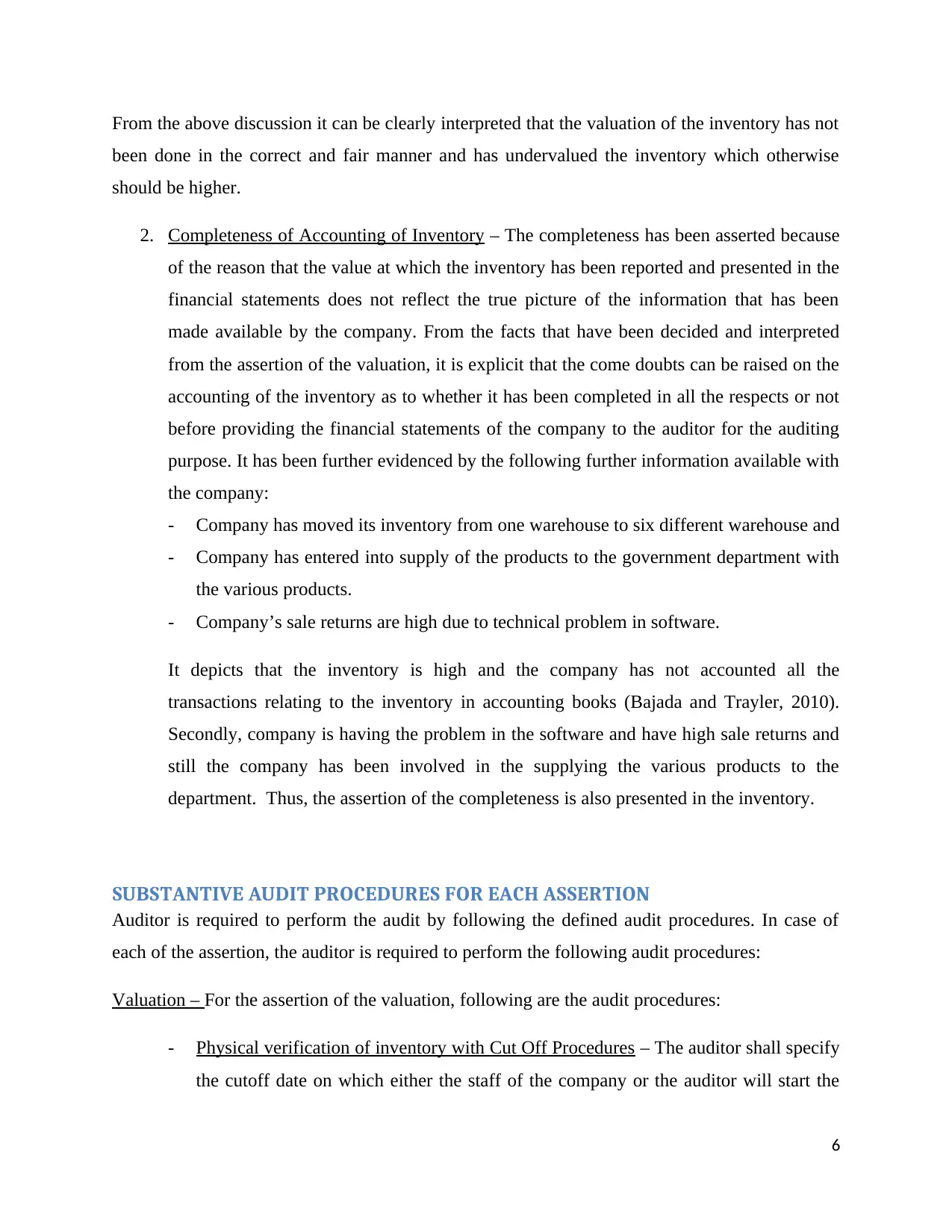
From the above discussion it can be clearly interpreted that the valuation of the inventory has not
been done in the correct and fair manner and has undervalued the inventory which otherwise
should be higher.
2. Completeness of Accounting of Inventory – The completeness has been asserted because
of the reason that the value at which the inventory has been reported and presented in the
financial statements does not reflect the true picture of the information that has been
made available by the company. From the facts that have been decided and interpreted
from the assertion of the valuation, it is explicit that the come doubts can be raised on the
accounting of the inventory as to whether it has been completed in all the respects or not
before providing the financial statements of the company to the auditor for the auditing
purpose. It has been further evidenced by the following further information available with
the company:
- Company has moved its inventory from one warehouse to six different warehouse and
- Company has entered into supply of the products to the government department with
the various products.
- Company’s sale returns are high due to technical problem in software.
It depicts that the inventory is high and the company has not accounted all the
transactions relating to the inventory in accounting books (Bajada and Trayler, 2010).
Secondly, company is having the problem in the software and have high sale returns and
still the company has been involved in the supplying the various products to the
department. Thus, the assertion of the completeness is also presented in the inventory.
SUBSTANTIVE AUDIT PROCEDURES FOR EACH ASSERTION
Auditor is required to perform the audit by following the defined audit procedures. In case of
each of the assertion, the auditor is required to perform the following audit procedures:
Valuation – For the assertion of the valuation, following are the audit procedures:
- Physical verification of inventory with Cut Off Procedures – The auditor shall specify
the cutoff date on which either the staff of the company or the auditor will start the
6
been done in the correct and fair manner and has undervalued the inventory which otherwise
should be higher.
2. Completeness of Accounting of Inventory – The completeness has been asserted because
of the reason that the value at which the inventory has been reported and presented in the
financial statements does not reflect the true picture of the information that has been
made available by the company. From the facts that have been decided and interpreted
from the assertion of the valuation, it is explicit that the come doubts can be raised on the
accounting of the inventory as to whether it has been completed in all the respects or not
before providing the financial statements of the company to the auditor for the auditing
purpose. It has been further evidenced by the following further information available with
the company:
- Company has moved its inventory from one warehouse to six different warehouse and
- Company has entered into supply of the products to the government department with
the various products.
- Company’s sale returns are high due to technical problem in software.
It depicts that the inventory is high and the company has not accounted all the
transactions relating to the inventory in accounting books (Bajada and Trayler, 2010).
Secondly, company is having the problem in the software and have high sale returns and
still the company has been involved in the supplying the various products to the
department. Thus, the assertion of the completeness is also presented in the inventory.
SUBSTANTIVE AUDIT PROCEDURES FOR EACH ASSERTION
Auditor is required to perform the audit by following the defined audit procedures. In case of
each of the assertion, the auditor is required to perform the following audit procedures:
Valuation – For the assertion of the valuation, following are the audit procedures:
- Physical verification of inventory with Cut Off Procedures – The auditor shall specify
the cutoff date on which either the staff of the company or the auditor will start the
6
⊘ This is a preview!⊘
Do you want full access?
Subscribe today to unlock all pages.

Trusted by 1+ million students worldwide
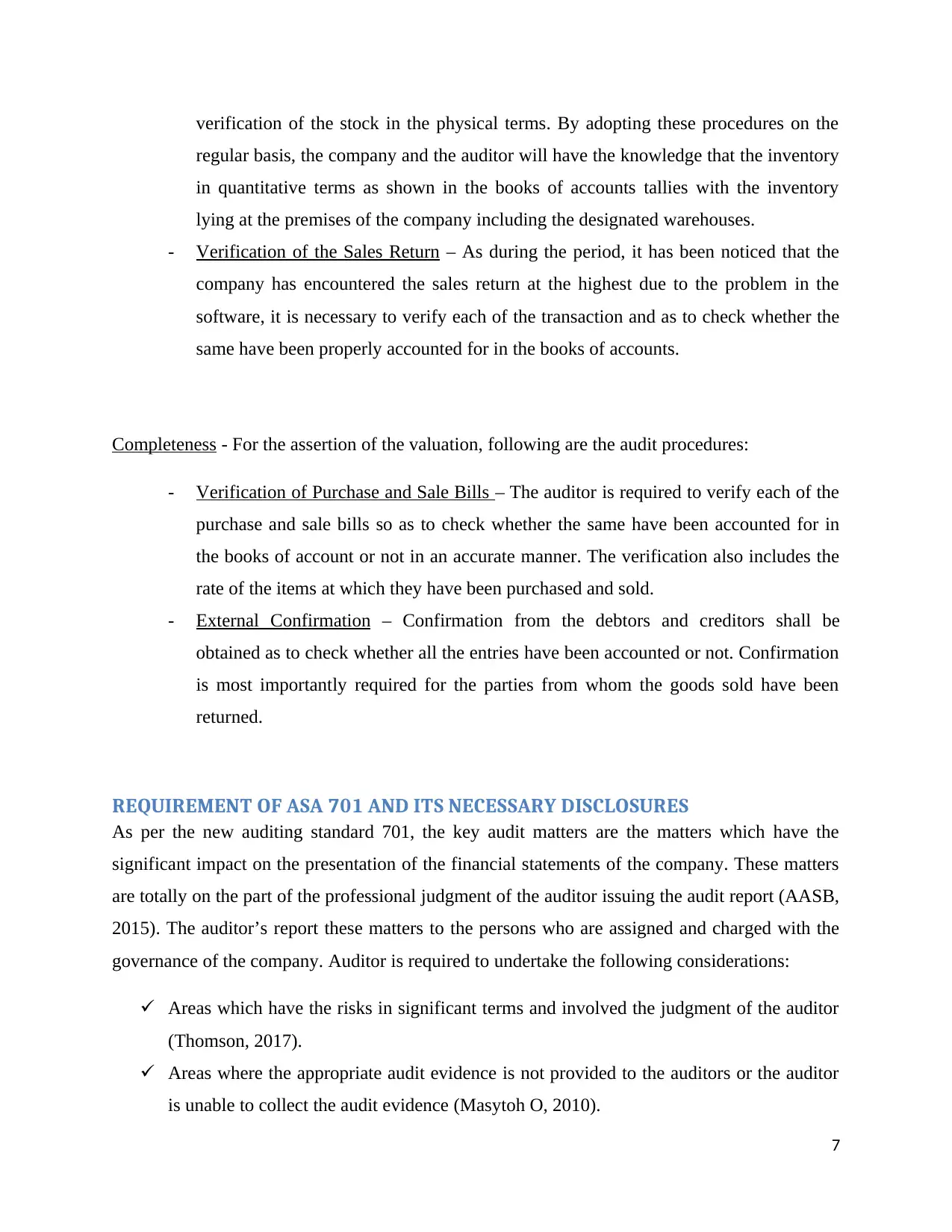
verification of the stock in the physical terms. By adopting these procedures on the
regular basis, the company and the auditor will have the knowledge that the inventory
in quantitative terms as shown in the books of accounts tallies with the inventory
lying at the premises of the company including the designated warehouses.
- Verification of the Sales Return – As during the period, it has been noticed that the
company has encountered the sales return at the highest due to the problem in the
software, it is necessary to verify each of the transaction and as to check whether the
same have been properly accounted for in the books of accounts.
Completeness - For the assertion of the valuation, following are the audit procedures:
- Verification of Purchase and Sale Bills – The auditor is required to verify each of the
purchase and sale bills so as to check whether the same have been accounted for in
the books of account or not in an accurate manner. The verification also includes the
rate of the items at which they have been purchased and sold.
- External Confirmation – Confirmation from the debtors and creditors shall be
obtained as to check whether all the entries have been accounted or not. Confirmation
is most importantly required for the parties from whom the goods sold have been
returned.
REQUIREMENT OF ASA 701 AND ITS NECESSARY DISCLOSURES
As per the new auditing standard 701, the key audit matters are the matters which have the
significant impact on the presentation of the financial statements of the company. These matters
are totally on the part of the professional judgment of the auditor issuing the audit report (AASB,
2015). The auditor’s report these matters to the persons who are assigned and charged with the
governance of the company. Auditor is required to undertake the following considerations:
Areas which have the risks in significant terms and involved the judgment of the auditor
(Thomson, 2017).
Areas where the appropriate audit evidence is not provided to the auditors or the auditor
is unable to collect the audit evidence (Masytoh O, 2010).
7
regular basis, the company and the auditor will have the knowledge that the inventory
in quantitative terms as shown in the books of accounts tallies with the inventory
lying at the premises of the company including the designated warehouses.
- Verification of the Sales Return – As during the period, it has been noticed that the
company has encountered the sales return at the highest due to the problem in the
software, it is necessary to verify each of the transaction and as to check whether the
same have been properly accounted for in the books of accounts.
Completeness - For the assertion of the valuation, following are the audit procedures:
- Verification of Purchase and Sale Bills – The auditor is required to verify each of the
purchase and sale bills so as to check whether the same have been accounted for in
the books of account or not in an accurate manner. The verification also includes the
rate of the items at which they have been purchased and sold.
- External Confirmation – Confirmation from the debtors and creditors shall be
obtained as to check whether all the entries have been accounted or not. Confirmation
is most importantly required for the parties from whom the goods sold have been
returned.
REQUIREMENT OF ASA 701 AND ITS NECESSARY DISCLOSURES
As per the new auditing standard 701, the key audit matters are the matters which have the
significant impact on the presentation of the financial statements of the company. These matters
are totally on the part of the professional judgment of the auditor issuing the audit report (AASB,
2015). The auditor’s report these matters to the persons who are assigned and charged with the
governance of the company. Auditor is required to undertake the following considerations:
Areas which have the risks in significant terms and involved the judgment of the auditor
(Thomson, 2017).
Areas where the appropriate audit evidence is not provided to the auditors or the auditor
is unable to collect the audit evidence (Masytoh O, 2010).
7
Paraphrase This Document
Need a fresh take? Get an instant paraphrase of this document with our AI Paraphraser
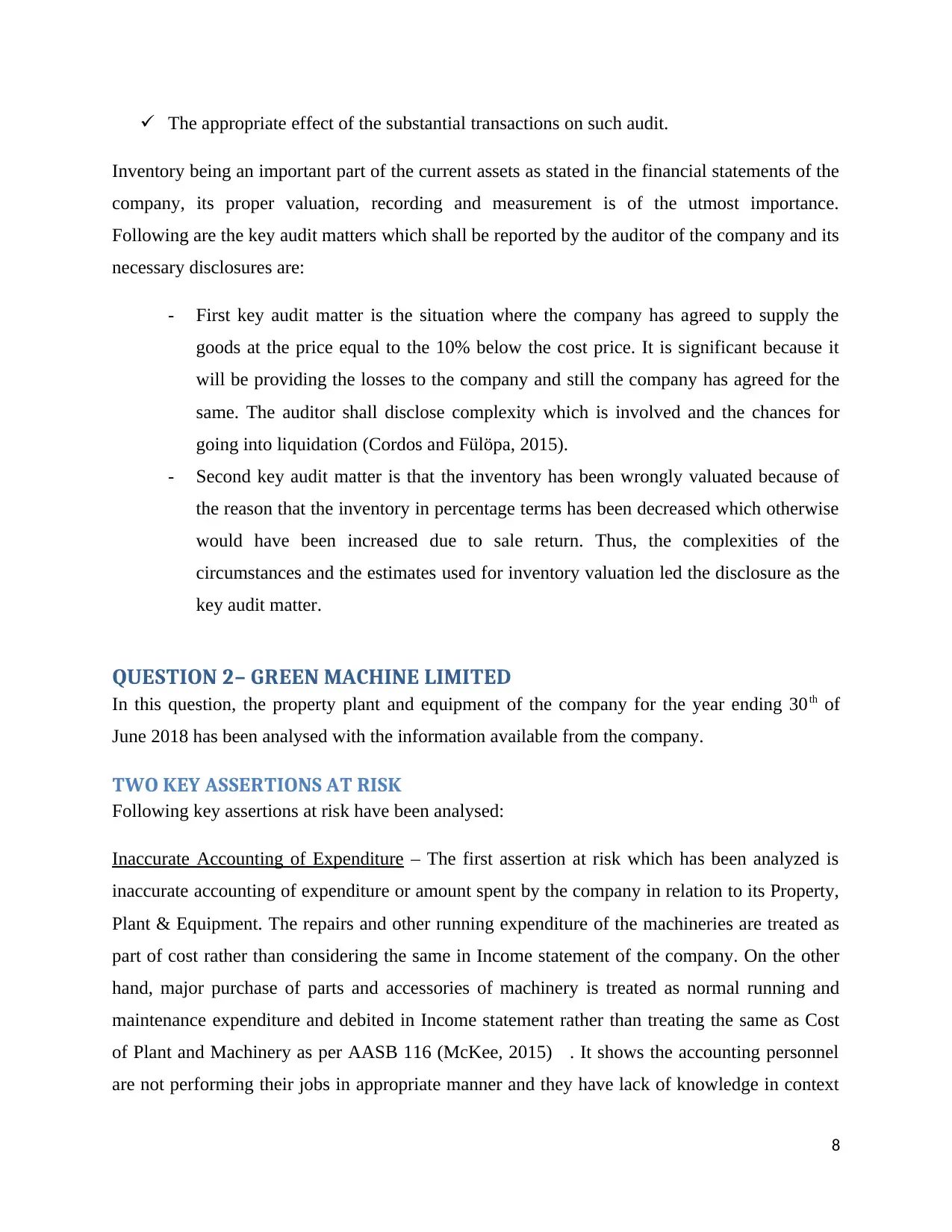
The appropriate effect of the substantial transactions on such audit.
Inventory being an important part of the current assets as stated in the financial statements of the
company, its proper valuation, recording and measurement is of the utmost importance.
Following are the key audit matters which shall be reported by the auditor of the company and its
necessary disclosures are:
- First key audit matter is the situation where the company has agreed to supply the
goods at the price equal to the 10% below the cost price. It is significant because it
will be providing the losses to the company and still the company has agreed for the
same. The auditor shall disclose complexity which is involved and the chances for
going into liquidation (Cordos and Fülöpa, 2015).
- Second key audit matter is that the inventory has been wrongly valuated because of
the reason that the inventory in percentage terms has been decreased which otherwise
would have been increased due to sale return. Thus, the complexities of the
circumstances and the estimates used for inventory valuation led the disclosure as the
key audit matter.
QUESTION 2– GREEN MACHINE LIMITED
In this question, the property plant and equipment of the company for the year ending 30th of
June 2018 has been analysed with the information available from the company.
TWO KEY ASSERTIONS AT RISK
Following key assertions at risk have been analysed:
Inaccurate Accounting of Expenditure – The first assertion at risk which has been analyzed is
inaccurate accounting of expenditure or amount spent by the company in relation to its Property,
Plant & Equipment. The repairs and other running expenditure of the machineries are treated as
part of cost rather than considering the same in Income statement of the company. On the other
hand, major purchase of parts and accessories of machinery is treated as normal running and
maintenance expenditure and debited in Income statement rather than treating the same as Cost
of Plant and Machinery as per AASB 116 (McKee, 2015) . It shows the accounting personnel
are not performing their jobs in appropriate manner and they have lack of knowledge in context
8
Inventory being an important part of the current assets as stated in the financial statements of the
company, its proper valuation, recording and measurement is of the utmost importance.
Following are the key audit matters which shall be reported by the auditor of the company and its
necessary disclosures are:
- First key audit matter is the situation where the company has agreed to supply the
goods at the price equal to the 10% below the cost price. It is significant because it
will be providing the losses to the company and still the company has agreed for the
same. The auditor shall disclose complexity which is involved and the chances for
going into liquidation (Cordos and Fülöpa, 2015).
- Second key audit matter is that the inventory has been wrongly valuated because of
the reason that the inventory in percentage terms has been decreased which otherwise
would have been increased due to sale return. Thus, the complexities of the
circumstances and the estimates used for inventory valuation led the disclosure as the
key audit matter.
QUESTION 2– GREEN MACHINE LIMITED
In this question, the property plant and equipment of the company for the year ending 30th of
June 2018 has been analysed with the information available from the company.
TWO KEY ASSERTIONS AT RISK
Following key assertions at risk have been analysed:
Inaccurate Accounting of Expenditure – The first assertion at risk which has been analyzed is
inaccurate accounting of expenditure or amount spent by the company in relation to its Property,
Plant & Equipment. The repairs and other running expenditure of the machineries are treated as
part of cost rather than considering the same in Income statement of the company. On the other
hand, major purchase of parts and accessories of machinery is treated as normal running and
maintenance expenditure and debited in Income statement rather than treating the same as Cost
of Plant and Machinery as per AASB 116 (McKee, 2015) . It shows the accounting personnel
are not performing their jobs in appropriate manner and they have lack of knowledge in context
8
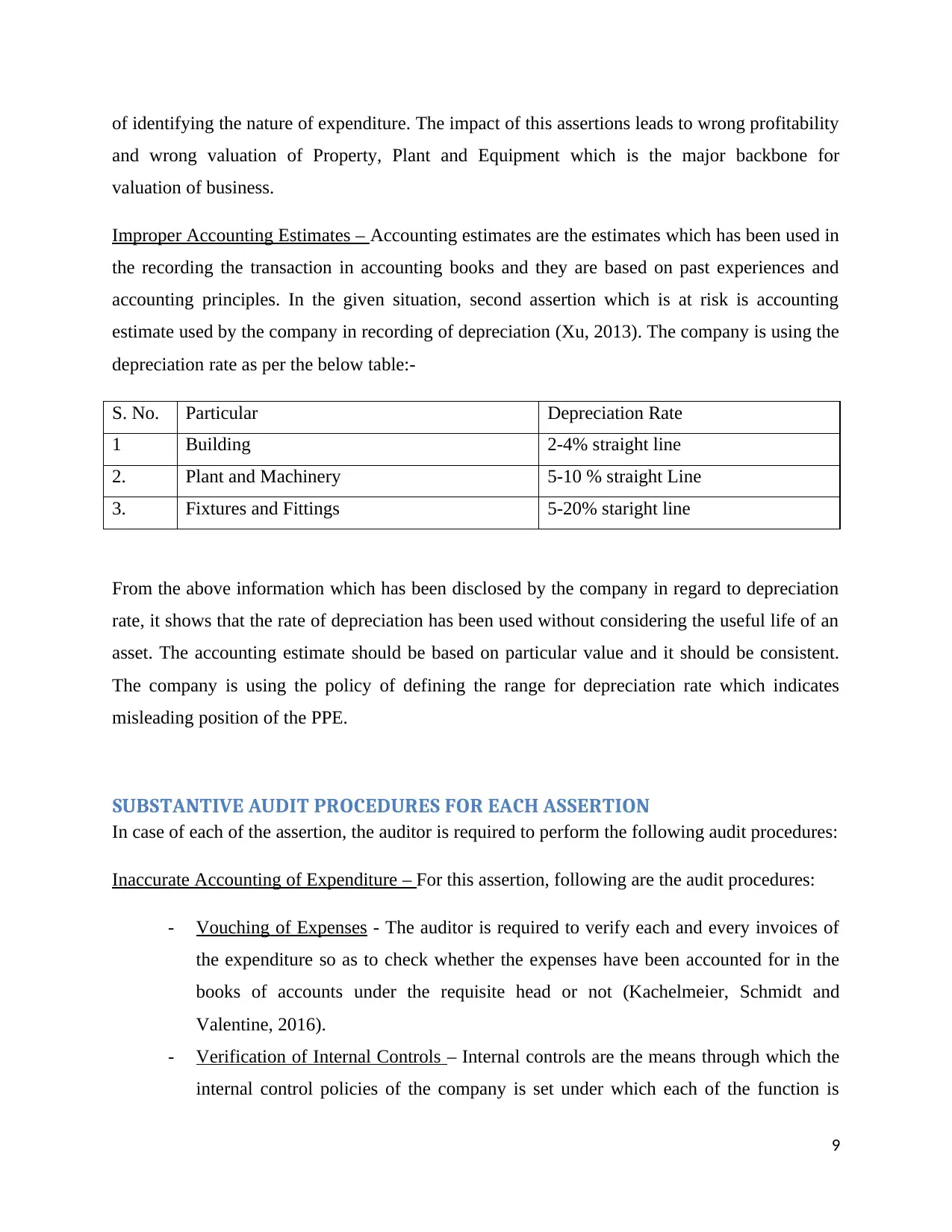
of identifying the nature of expenditure. The impact of this assertions leads to wrong profitability
and wrong valuation of Property, Plant and Equipment which is the major backbone for
valuation of business.
Improper Accounting Estimates – Accounting estimates are the estimates which has been used in
the recording the transaction in accounting books and they are based on past experiences and
accounting principles. In the given situation, second assertion which is at risk is accounting
estimate used by the company in recording of depreciation (Xu, 2013). The company is using the
depreciation rate as per the below table:-
S. No. Particular Depreciation Rate
1 Building 2-4% straight line
2. Plant and Machinery 5-10 % straight Line
3. Fixtures and Fittings 5-20% staright line
From the above information which has been disclosed by the company in regard to depreciation
rate, it shows that the rate of depreciation has been used without considering the useful life of an
asset. The accounting estimate should be based on particular value and it should be consistent.
The company is using the policy of defining the range for depreciation rate which indicates
misleading position of the PPE.
SUBSTANTIVE AUDIT PROCEDURES FOR EACH ASSERTION
In case of each of the assertion, the auditor is required to perform the following audit procedures:
Inaccurate Accounting of Expenditure – For this assertion, following are the audit procedures:
- Vouching of Expenses - The auditor is required to verify each and every invoices of
the expenditure so as to check whether the expenses have been accounted for in the
books of accounts under the requisite head or not (Kachelmeier, Schmidt and
Valentine, 2016).
- Verification of Internal Controls – Internal controls are the means through which the
internal control policies of the company is set under which each of the function is
9
and wrong valuation of Property, Plant and Equipment which is the major backbone for
valuation of business.
Improper Accounting Estimates – Accounting estimates are the estimates which has been used in
the recording the transaction in accounting books and they are based on past experiences and
accounting principles. In the given situation, second assertion which is at risk is accounting
estimate used by the company in recording of depreciation (Xu, 2013). The company is using the
depreciation rate as per the below table:-
S. No. Particular Depreciation Rate
1 Building 2-4% straight line
2. Plant and Machinery 5-10 % straight Line
3. Fixtures and Fittings 5-20% staright line
From the above information which has been disclosed by the company in regard to depreciation
rate, it shows that the rate of depreciation has been used without considering the useful life of an
asset. The accounting estimate should be based on particular value and it should be consistent.
The company is using the policy of defining the range for depreciation rate which indicates
misleading position of the PPE.
SUBSTANTIVE AUDIT PROCEDURES FOR EACH ASSERTION
In case of each of the assertion, the auditor is required to perform the following audit procedures:
Inaccurate Accounting of Expenditure – For this assertion, following are the audit procedures:
- Vouching of Expenses - The auditor is required to verify each and every invoices of
the expenditure so as to check whether the expenses have been accounted for in the
books of accounts under the requisite head or not (Kachelmeier, Schmidt and
Valentine, 2016).
- Verification of Internal Controls – Internal controls are the means through which the
internal control policies of the company is set under which each of the function is
9
⊘ This is a preview!⊘
Do you want full access?
Subscribe today to unlock all pages.

Trusted by 1+ million students worldwide
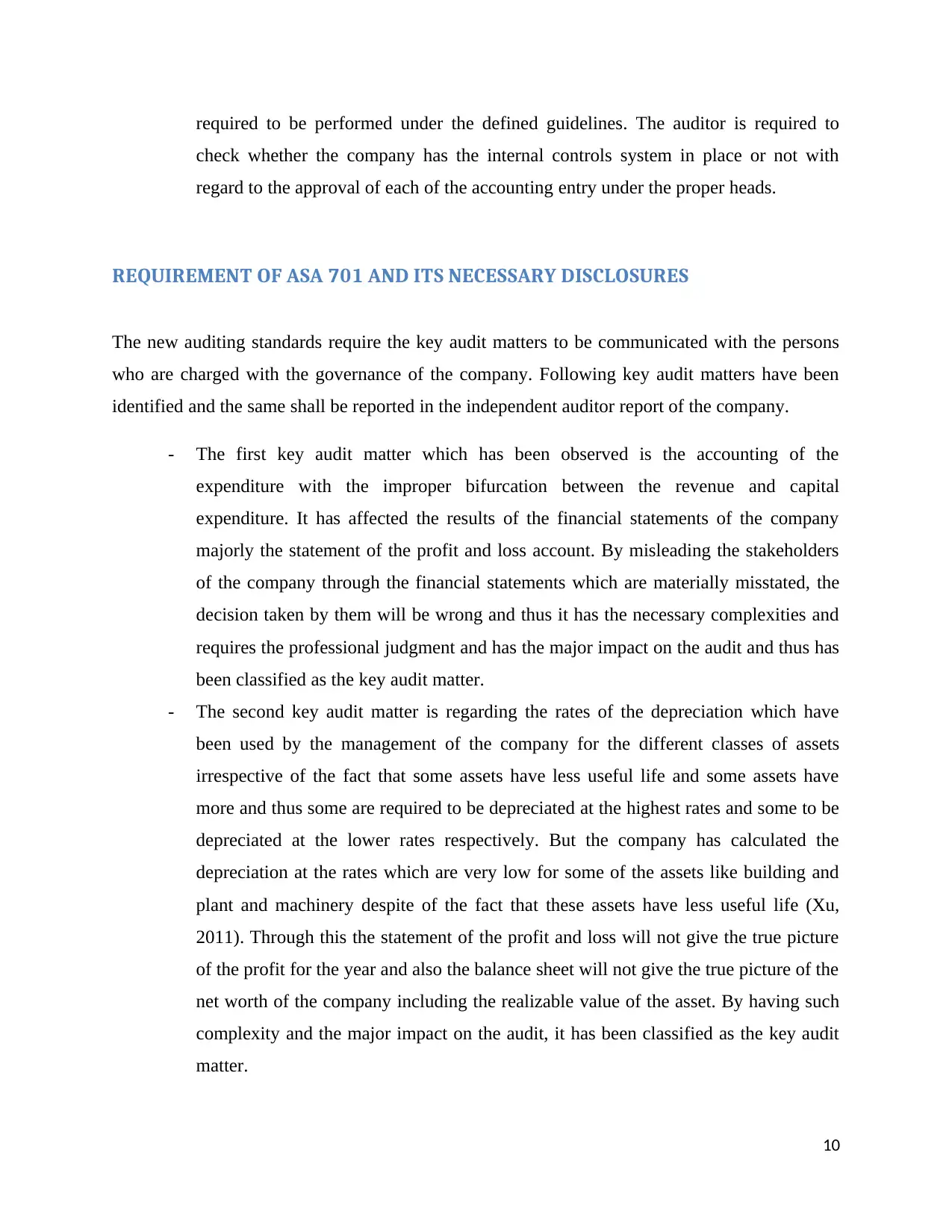
required to be performed under the defined guidelines. The auditor is required to
check whether the company has the internal controls system in place or not with
regard to the approval of each of the accounting entry under the proper heads.
REQUIREMENT OF ASA 701 AND ITS NECESSARY DISCLOSURES
The new auditing standards require the key audit matters to be communicated with the persons
who are charged with the governance of the company. Following key audit matters have been
identified and the same shall be reported in the independent auditor report of the company.
- The first key audit matter which has been observed is the accounting of the
expenditure with the improper bifurcation between the revenue and capital
expenditure. It has affected the results of the financial statements of the company
majorly the statement of the profit and loss account. By misleading the stakeholders
of the company through the financial statements which are materially misstated, the
decision taken by them will be wrong and thus it has the necessary complexities and
requires the professional judgment and has the major impact on the audit and thus has
been classified as the key audit matter.
- The second key audit matter is regarding the rates of the depreciation which have
been used by the management of the company for the different classes of assets
irrespective of the fact that some assets have less useful life and some assets have
more and thus some are required to be depreciated at the highest rates and some to be
depreciated at the lower rates respectively. But the company has calculated the
depreciation at the rates which are very low for some of the assets like building and
plant and machinery despite of the fact that these assets have less useful life (Xu,
2011). Through this the statement of the profit and loss will not give the true picture
of the profit for the year and also the balance sheet will not give the true picture of the
net worth of the company including the realizable value of the asset. By having such
complexity and the major impact on the audit, it has been classified as the key audit
matter.
10
check whether the company has the internal controls system in place or not with
regard to the approval of each of the accounting entry under the proper heads.
REQUIREMENT OF ASA 701 AND ITS NECESSARY DISCLOSURES
The new auditing standards require the key audit matters to be communicated with the persons
who are charged with the governance of the company. Following key audit matters have been
identified and the same shall be reported in the independent auditor report of the company.
- The first key audit matter which has been observed is the accounting of the
expenditure with the improper bifurcation between the revenue and capital
expenditure. It has affected the results of the financial statements of the company
majorly the statement of the profit and loss account. By misleading the stakeholders
of the company through the financial statements which are materially misstated, the
decision taken by them will be wrong and thus it has the necessary complexities and
requires the professional judgment and has the major impact on the audit and thus has
been classified as the key audit matter.
- The second key audit matter is regarding the rates of the depreciation which have
been used by the management of the company for the different classes of assets
irrespective of the fact that some assets have less useful life and some assets have
more and thus some are required to be depreciated at the highest rates and some to be
depreciated at the lower rates respectively. But the company has calculated the
depreciation at the rates which are very low for some of the assets like building and
plant and machinery despite of the fact that these assets have less useful life (Xu,
2011). Through this the statement of the profit and loss will not give the true picture
of the profit for the year and also the balance sheet will not give the true picture of the
net worth of the company including the realizable value of the asset. By having such
complexity and the major impact on the audit, it has been classified as the key audit
matter.
10
Paraphrase This Document
Need a fresh take? Get an instant paraphrase of this document with our AI Paraphraser

CONCLUSION AND RECOMMENDATION
The report issued by the auditor plays significant role in the financial industry as all the
stakeholders of the respective company on the basis of this report take decisions in response to
the company. The decision may be related to the investment in equity or financing of loans by
the financial institutions or taking up an employment in the company and etc. With the
emergence and the applicability of the new auditing standard, the importance of the auditor’s
report has been further increased and the same has been welcomed by the stakeholders including
the government authorities. Through this report, the basic and important content of the balance
sheet have been analysed. One is inventory and the other one is property plant and equipment.
The key risk assertions have been properly identified and the respective audit procedures have
been detailed with proper references. In order to conclude the report, the concepts have been
exhibited and the importance of auditing function has been properly laid down.
The recommendation from the findings of the report is that the audit shall be conducted in a
much defined manner and the key matters shall be reported so as to enable the users and the
stakeholders to make the effective and efficient decision.
REFERENCES
AASB, (2015), “ASA 701, Communicating Key Audit Matters in the Independents Auditors
report”, available on http://www.auasb.gov.au/admin/file/content102/c3/ASA_701_2015.pdf
accessed at 18/01/2019.
Bajada, C. and Trayler, R., (2010). “How Australia Survived the Global Financial Crisis. The
Financial and Economic Crises: An International Perspective”, Edward Elgar: Cheltenham, UK
and Northampton, USA, pp.139-154.
Cordos, G.S. and Fülöpa, M.T., (2015), “Understanding audit reporting changes: introduction of
Key Audit Matters.” Accounting and Management Information Systems, 14(1), p.128.
Kachelmeier, S.J., Schmidt, J.J. and Valentine, K.,(2016). “The disclaimer effect of disclosing
critical audit matters in the auditor’s report.”, Accounting Journal, Vol 5, pp 22-26
11
The report issued by the auditor plays significant role in the financial industry as all the
stakeholders of the respective company on the basis of this report take decisions in response to
the company. The decision may be related to the investment in equity or financing of loans by
the financial institutions or taking up an employment in the company and etc. With the
emergence and the applicability of the new auditing standard, the importance of the auditor’s
report has been further increased and the same has been welcomed by the stakeholders including
the government authorities. Through this report, the basic and important content of the balance
sheet have been analysed. One is inventory and the other one is property plant and equipment.
The key risk assertions have been properly identified and the respective audit procedures have
been detailed with proper references. In order to conclude the report, the concepts have been
exhibited and the importance of auditing function has been properly laid down.
The recommendation from the findings of the report is that the audit shall be conducted in a
much defined manner and the key matters shall be reported so as to enable the users and the
stakeholders to make the effective and efficient decision.
REFERENCES
AASB, (2015), “ASA 701, Communicating Key Audit Matters in the Independents Auditors
report”, available on http://www.auasb.gov.au/admin/file/content102/c3/ASA_701_2015.pdf
accessed at 18/01/2019.
Bajada, C. and Trayler, R., (2010). “How Australia Survived the Global Financial Crisis. The
Financial and Economic Crises: An International Perspective”, Edward Elgar: Cheltenham, UK
and Northampton, USA, pp.139-154.
Cordos, G.S. and Fülöpa, M.T., (2015), “Understanding audit reporting changes: introduction of
Key Audit Matters.” Accounting and Management Information Systems, 14(1), p.128.
Kachelmeier, S.J., Schmidt, J.J. and Valentine, K.,(2016). “The disclaimer effect of disclosing
critical audit matters in the auditor’s report.”, Accounting Journal, Vol 5, pp 22-26
11
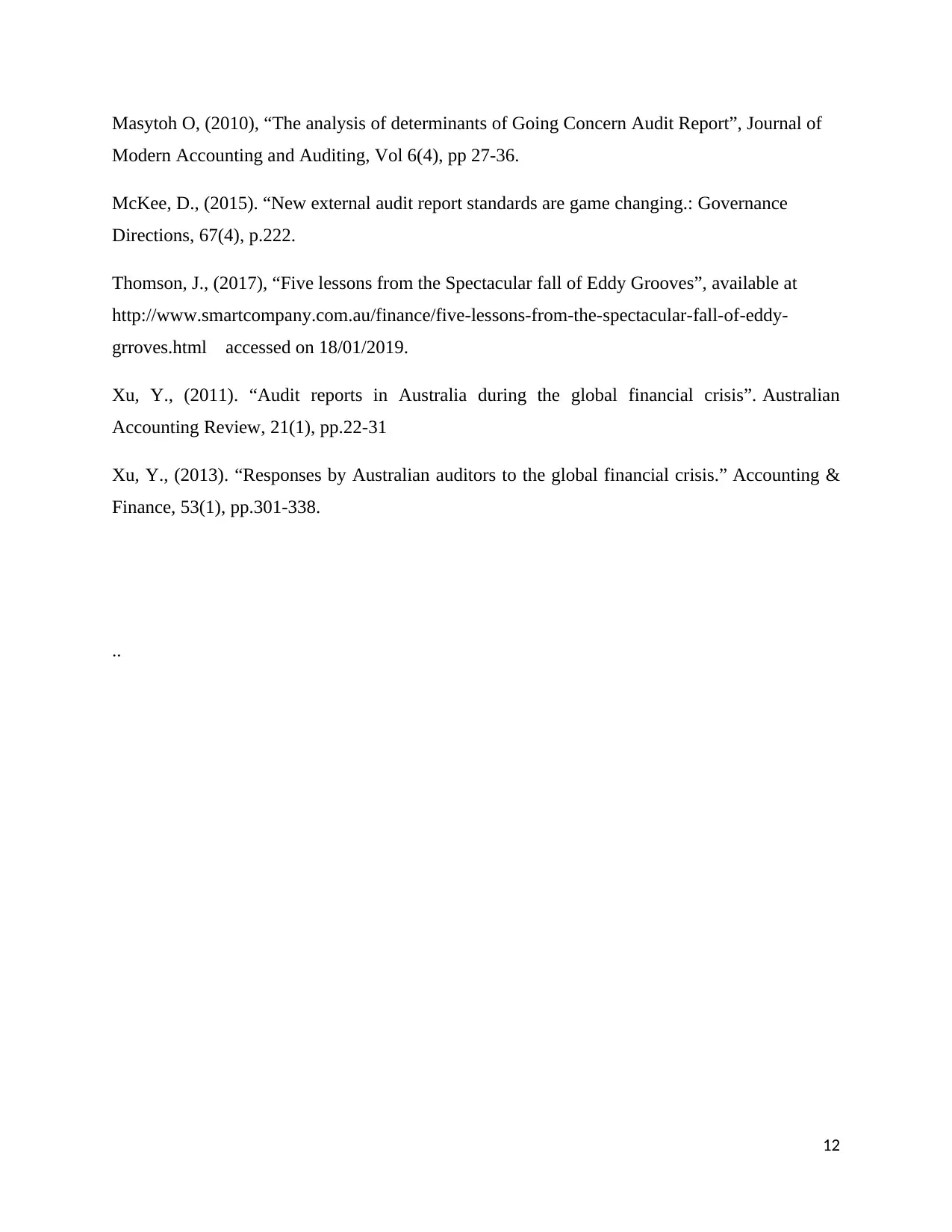
Masytoh O, (2010), “The analysis of determinants of Going Concern Audit Report”, Journal of
Modern Accounting and Auditing, Vol 6(4), pp 27-36.
McKee, D., (2015). “New external audit report standards are game changing.: Governance
Directions, 67(4), p.222.
Thomson, J., (2017), “Five lessons from the Spectacular fall of Eddy Grooves”, available at
http://www.smartcompany.com.au/finance/five-lessons-from-the-spectacular-fall-of-eddy-
grroves.html accessed on 18/01/2019.
Xu, Y., (2011). “Audit reports in Australia during the global financial crisis”. Australian
Accounting Review, 21(1), pp.22-31
Xu, Y., (2013). “Responses by Australian auditors to the global financial crisis.” Accounting &
Finance, 53(1), pp.301-338.
..
12
Modern Accounting and Auditing, Vol 6(4), pp 27-36.
McKee, D., (2015). “New external audit report standards are game changing.: Governance
Directions, 67(4), p.222.
Thomson, J., (2017), “Five lessons from the Spectacular fall of Eddy Grooves”, available at
http://www.smartcompany.com.au/finance/five-lessons-from-the-spectacular-fall-of-eddy-
grroves.html accessed on 18/01/2019.
Xu, Y., (2011). “Audit reports in Australia during the global financial crisis”. Australian
Accounting Review, 21(1), pp.22-31
Xu, Y., (2013). “Responses by Australian auditors to the global financial crisis.” Accounting &
Finance, 53(1), pp.301-338.
..
12
⊘ This is a preview!⊘
Do you want full access?
Subscribe today to unlock all pages.

Trusted by 1+ million students worldwide
1 out of 12
Related Documents
Your All-in-One AI-Powered Toolkit for Academic Success.
+13062052269
info@desklib.com
Available 24*7 on WhatsApp / Email
![[object Object]](/_next/static/media/star-bottom.7253800d.svg)
Unlock your academic potential
© 2024 | Zucol Services PVT LTD | All rights reserved.





